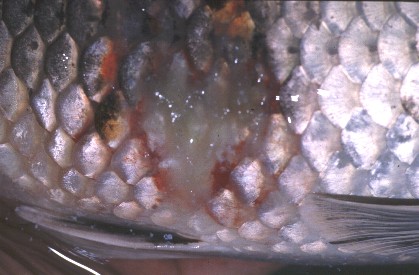Fungus and water moulds – what are they?
Fungus is a common fish disease that can prove fatal if not treated early. Most fungal infections involve water moulds from the class Oomycetes (a group of fungi with similar characteristics). Although there are several water moulds that can affect fish, the most common and significant water mould is Saprolegnia, a filamentous fungi. In common with all moulds, it feeds by secreting digestive enzymes onto the surrounding area. These enzymes break down cells and tissues enabling the fungi to absorb nutrients such as proteins and carbohydrates. This isn’t a problem if it’s a piece of fish food – but it’s not so welcome when it is one of your fish that is being slowly digested!
Fish fungus – Saprolegnia |
|
|
|
|
|
photo: Frank Prince-Iles |
|
Water moulds are saprotrophs – that is they normally feed on dead organic matter such as fish wastes, uneaten food etc, however they are also opportunistic parasites, able to take advantage of damaged or stressed fish. Fungal infections are called mycoses.
Water moulds consist of a tangled mass of individual filaments called hyphae. As the mass grows it forms compact tufts that are collectively called a mycelium. The mass of fungi filaments or mycelium can be seen clearly without a microscope. Moulds reproduce by releasing thousands of spores into the surrounding water. The fungal spores are highly resistant to drying and chemical attack and thus Saprolegnia spores and molds are common in all ponds and tanks.
It is believed that the fish mucus contains effective fungicides that prevent fungal growths under normal circumstances. It is worth pointing out that large amounts of decomposing organic matter within the system will encourage fungal growth.
A dangerous secondary infection
Saprolegniasis is mainly a secondary infection seen after damage to the fish integument (skin and gills) caused by parasites, viruses, bacterial infections and other skin damage. Other predisposing factors include water pollution and overcrowding. Less commonly, Saprolegnia can act as a primary pathogen infecting fish that haven’t shown signs of previous damage. It is believed that such attacks are temperature-dependant, usually occurring at low temperatures, possibly as a consequence of a reduced immune response. I have seen two separate cases recently involving orfe that were severely infected without any other signs of damage.
As well as being a threat to fish, fungus can also affect fish eggs. It is usually the infertile eggs that are first infected, but if untreated the fungus soon spreads to nearby, healthy eggs.
Clinical signs
Fish fungus appears as grey/white patches on the skin or gills that resemble tufts of cotton-wool. At a later stage they may become brown or green as they trap sediment or algae. If the fish is removed from the water, the fungus appears as a slimy matted mass. Saprolegnia normally establishes as small, focal infections that then spread rapidly over the body or gills. As it spreads, healthy tissue is destroyed. There is often little inflammation unless there is an underlying bacterial infection. Microscopic examination shows broad, non-septate (no dividing cell walls) hyphae of varying diameters.
Don’t underestimate the danger
Although most infections are fairly superficial, rarely penetrating beyond the superficial muscles, the danger comes from the speed at which Saprolegnia can spread and the amount of surface area that is often damaged. This in turns leads to serum and protein loss. There is sometimes a tendency to underestimate the potential danger of fungal infections and it is important to realise that even superficial damage of the skin or gills can prove fatal if not treated. The chances of recovery from saprolegniasis are directly related to the area of integument affected, which is why prompt diagnosis and treatment is vital.
Treatment
Fish fungal infections are difficult to treat and mould cannot ever be eliminated from any fish keeping systems. Any treatment plan must take account of any predisposing factors and these should be resolved / or treated at the same time.
Topical treatments:
- Use strong malachite green solution (100mg/ litre) as a topical to clean the lesion and apply a water-proof cream.
Long-term bath treatments:
- Salt: 1–5g / litre indefinitely
- Malachite green: 0.10mg/litre – as a bath for three treatments at three-day intervals

